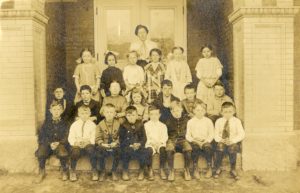Students examine photographs from ca. 1918 to connect to the past and then reflect on their own lives during Covid-19 and share what is important to them in a virtual time capsule.
Grade Level: Elementary
Topics: 1918 Flu Pandemic, Covid-19 Pandemic, History of Schools
Compelling Question: What would you like kids in the future to know about your life during Covid-19?
Historical Thinking Skills: Chronological Thinking; Then and Now
Teacher Preparation
Preparation: Ask your historical society for a class photograph from around 1918 and a photograph of the school. It would be helpful to at least know the school district #.
Ask your historical society if they would like to receive time capsules for their collection. If so, they might write a letter to your students like this one from Norwich.
Activating Prior Knowledge
- Discuss how it has been to shelter in place.
- Read this background essay on the 1918 flu in Vermont.
Investigating Primary Sources
- Connect to the 1918 students—Use visual thinking skills to look closely at the photograph. If you don’t have one, here is a photograph from Norwich. How many students are in the photograph? What do you notice about them? etc. Does the photograph provide the children’s names? What are they wearing? Are they all the same age?
Talk about how these children would have experienced the 1918 Flu pandemic.
- Find the school—Find the 1869 Beers Atlas Map for your Vermont town or the 1892 NH State Atlas. The school districts are identified on these maps by colors and lines. Can your students figure out where the children in the photograph went to school? It’s possible they won’t if the 1918 school didn’t exist in 1869. You can layer the 1869 map onto a contemporary map by using the Overlay feature at the bottom of the page
- Read the letter from your historical society or one you write adapted from Norwich.
- Discuss the categories of items in the letter that children might have collected in 1918. Brainstorm what the children might gather for their time capsules.
Summative Assessment
Create a virtual time capsule. Identify 3 or 4 items that have been important to you while being safer at home. Photograph them and write a paragraph for each explaining why they have been important to you. Your virtual “time capsule” will be donated to the historical society for future historians.
Primary Sources and Worksheets Used in the Lesson
Background essay on the 1918 flu in Vermont
1918 school photo from your town or this photograph from Norwich
1869 VT Beers Atlas Map for your town or the 1892 NH State Atlas
Another possible primary source would be a town report from 1919. The school report might discuss the flu. Your town clerk or historical society would have this. The public library might also have it.
Time capsule letter from your Historical Society or one you write adapted from Norwich
Here are some examples from Norwich students:
My Chessboard
This is what I would put in a time capsule to record my time during the COVID-19 pandemic:
This is a picture of my chess board and it has entertained me and my sister through the pandemic. This chessboard is very helpful because it is a quiet game that doesn’t go on screens. It is sometimes very boring at my house so it comes in handy to be able to play a board game. The chessboard in the picture to the left is very portable and can be taken just about anywhere. We bought this chess board while on vacation in Santori. It reminds me of Greece because the chess pieces are Greek Gods and Goddess. Overall this board is very portable, very fun, and it is a very unique chess board.
Zoom and Google Classroom
I like using zoom and google classroom to hang out with my friends and learn in this new strange way. I think google classroom is harder than learning in real life, but I like that I get to do my work without a timer. I don’t know why but I like clicking links, and I like zoom so now I can click a link that takes me to a zoom meeting. If all these crazy things hadn’t happened, I probably would not find out about zoom or google classroom for a couple of years.
